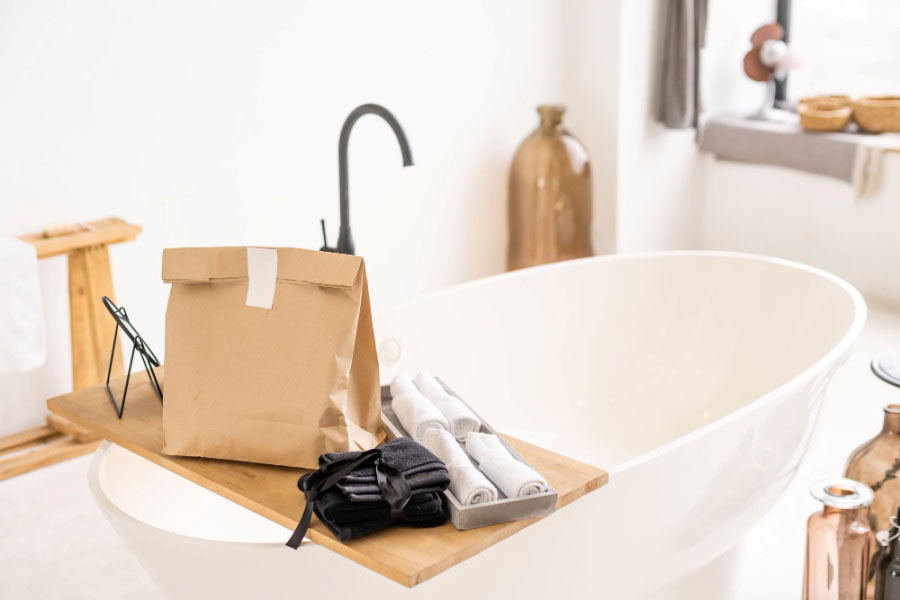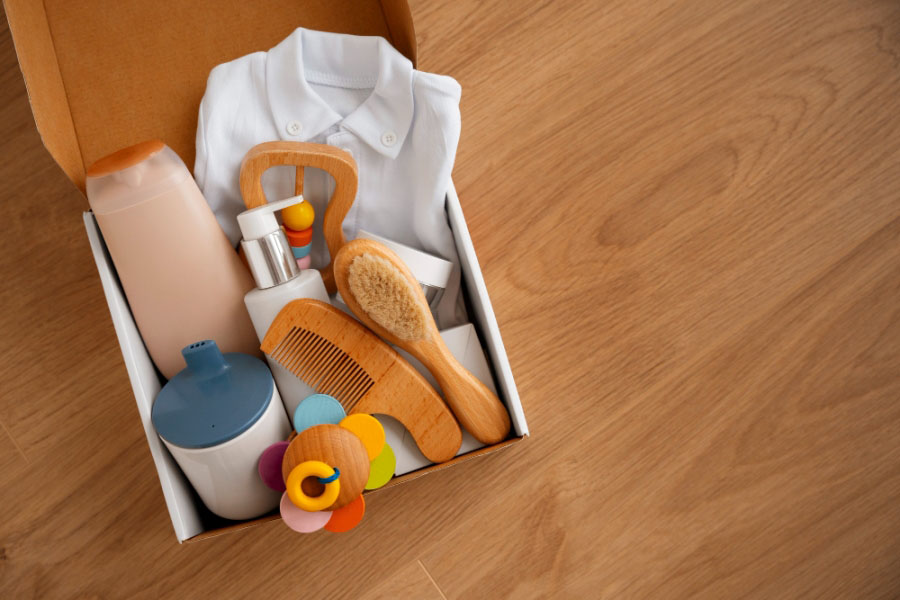How to Pack Your Bathroom for Moving: A Step-by-Step Guide
Let's be honest, figuring out how to pack a bathroom for moving can feel like solving a tricky puzzle with way too many small, leaky pieces. Learning the best way to get all those lotions, potions, and towels from one home to the next without a major mess is a skill, and trust me, it’s one I learned the hard way after a cross-country move from Seattle to Charlotte.
How much will my move cost?
Let us help match you
Thank you!
Your movers will contact you shortly.

Written by: National Movers Team
NationalMovers team provides expert insights, mover comparisons, and practical resources to help you make informed moving decisions. Whether you need company reviews, relocation tips, or expert guidance, we’ve got you covered. Read more
Reviewed by: Sarah Mitchell
Meet Sarah Mitchell of National Movers: logistics pro, moving expert, and your go-to guide for stress-free tips, smart packing hacks, and honest advice.Read more
Last Update: 07/07/2025
The bathroom is often the last room we pack and the first one we need upon arrival. It’s a tiny space that holds a surprising amount of stuff – from half-empty shampoo bottles to that one fancy soap you’ve been saving for a special occasion. Getting it wrong can mean arriving at your new home to find your favorite sweater soaked in peppermint body wash. No one wants that.
But don’t you worry. I’ve juggled logistics for a moving company and packed up my own life more times than I can count. I’m here to walk you through it, step-by-step, so you can conquer the bathroom with a smile.
- Declutter First: Get rid of expired and unused items to lighten your load.
- “First Night” Box is Essential: Pack a separate bag with everything you’ll need on day one and keep it with you.
- Seal All Liquids: Use the plastic wrap trick and sealable bags to prevent leaks. It’s the best way to pack toiletries for moving.
- Pad Fragile Items: Wrap glass and ceramic items individually and cushion them well.
- Use Towels Strategically: Use towels and linens for padding and to fill empty spaces in boxes.
- Don’t Pack Hazardous Items: Set aside cleaners, aerosols, and flammables for proper disposal.
- Label Specifically: Clearly mark each box with its contents and “FRAGILE” if needed.
Best Overall Value Best Overall Value

- Nationwide availability
- Clear pricing, no hidden fees
- Premium door-to-door service
Need Help? Call Now
855-930-4574- Nationwide availability, over 25 years of experience, premium door-to-door service

- Reliable moving & Storage solutions
- Top-quality services, trained staff
- Reliable moving & Storage solutions, top-quality services, trained staff
Why Packing the Bathroom Requires Special Attention

So, what makes the bathroom such a unique challenge? Unlike the living room with its sturdy books and furniture, the bathroom is like the wild west of packing. It’s a collection of liquids, fragile glass bottles, and items you need right up until the last minute.
Think about it:
- Liquids, Liquids Everywhere: Shampoos, conditioners, lotions, mouthwash – the potential for a gooey explosion is high. A single loose cap can create a sticky situation that ruins everything else in the box.
- Fragile Items: Perfume bottles, glass jars of skincare, and that ceramic soap dish are all delicate. They need extra care to survive the bumps and jostles of a moving truck.
- Must-Have Essentials: You can’t exactly pack your toothbrush, toothpaste, and toilet paper a week in advance. You need these items until the very last morning and, bless your heart, you’ll need them the very first night in your new place.
- Hazardous Materials: Many common bathroom cleaners, nail polish removers, and aerosols are considered hazardous materials that movers won’t transport. You have to know what you can and can’t pack.
It’s a room that demands a strategy. You can’t just toss everything into a box and hope for the best.
Bathroom Packing Supplies You’ll Need
Before you even think about putting anything in a box, let’s get our tools in order. Having the right supplies on hand makes all the difference between a smooth packing session and a frustrating mess. Here’s what I recommend grabbing from the store.
| Supply | Purpose |
| Small to Medium Boxes | Perfect for heavier items like toiletries, preventing the box from becoming too heavy to lift. |
| Packing Paper/Bubble Wrap | For wrapping fragile items like glass bottles, mirrors, and ceramic holders. |
| Plastic Wrap | The secret weapon against spills! Used to seal bottles before putting the cap back on. |
| Packing Tape | To securely seal boxes and reinforce the bottoms. Don’t skimp on quality here! |
| Sealable Plastic Bags | For grouping liquids and preventing any potential leaks from spreading. Gallon and quart sizes are great. |
| Toiletry Bag / "First Night" Box | To keep your absolute essentials separate and easily accessible. |
| Permanent Markers | For clear and specific labeling. You’ll thank yourself later. |
| Trash Bags | For decluttering. You’ll be surprised how much you can toss. |
Get matched with the best mover for your needs!
Thank you!
Your movers will contact you shortly.
Step-by-Step: How to Pack Your Bathroom for a Move

Alright, now that you have your supplies, let’s get into the nitty-gritty of packing kitchen for moving. The key is to have a system. Don’t just start throwing things in boxes. A little strategy goes a long way.
Alright, got your supplies? Let’s roll up our sleeves and get this done. The key is to break it down into manageable steps. Don’t try to do it all at once; just tackle one drawer or cabinet at a time.
Find the perfect mover to fit your needs – get your free instant moving quote now!
932-465-6888What NOT to Pack from Your Bathroom
This is a big one. Professional moving companies are prohibited from transporting hazardous or flammable materials for safety reasons. Many common bathroom items fall into this category. Before you pack, you need to set these aside for proper disposal or plan to transport them yourself.
Common bathroom items movers won’t move include:
- Aerosol cans (hairspray, air freshener)
- Nail polish and nail polish remover
- Bleach and ammonia-based cleaners
- Rubbing alcohol
- Anything containing flammable ingredients
Not sure about an item? Check the label for warnings like “flammable” or “combustible.” It’s always better to be safe than sorry. For a more complete list, you can check out our guide on Items Movers Won’t Move.
Organize and Label Clearly
You’re almost there! Once your boxes are packed and sealed, the final touch is labeling. Don’t just write “Bathroom” on the box. Trust me, when you’re exhausted and just want to find the hand soap, “Bathroom – Linens” or “Bathroom – Under Sink Toiletries” is a whole lot more helpful.
Being specific saves you time and stress during the unpacking process. For a complete rundown on the best labeling strategies, take a peek at our guide on How to Label Moving Boxes the Right Way.
Make Packing Your Bathroom Simple and Safe
Packing your bathroom doesn’t have to be a dreaded chore. With a little bit of planning, the right supplies, and a solid strategy, you can get it done efficiently and safely. By decluttering first, creating that all-important “First Night” box, and taking extra care with liquids, you’re setting yourself up for a much smoother transition into your new home and avoiding many common moving mistakes.
Remember, the goal is to arrive with your sanity – and your shampoo – intact. You’ve got this!
FAQs: Packing Your Bathroom for a Move
When should I pack my bathroom?
Since you’ll need many bathroom items until the very end, it’s one of the last rooms you should pack. A day or two before the move is usually a good time to pack everything except your “First Night” box essentials.
Can I pack cleaning supplies?
It depends. You can pack sponges and brushes, but most liquid cleaners, especially those containing bleach or ammonia, are considered hazardous materials. It’s best to use them up or dispose of them properly before you move and buy new ones when you arrive.
How do I keep bottles from leaking?
The plastic wrap trick is your best bet! Unscrew the cap, place a small piece of plastic wrap over the opening, and screw the cap back on. For extra security, place all liquid containers in a sealable plastic bag.
Should I pack makeup and skincare separately?
Yes, it’s a good idea. Grouping these items together makes them easier to find. Wrap any fragile compacts or glass bottles in bubble wrap or soft cloth, and consider using a dedicated makeup bag or train case for extra protection.
How to pack bathroom items when moving?
Start by decluttering. Then, gather your supplies and separate items into categories: liquids, fragiles, linens, and essentials. Pack your essentials in a “First Night” box to keep with you. For everything else, use small boxes, seal liquids carefully, wrap fragile items, and use towels as padding. Label everything clearly.
What is the hardest room to pack when moving?
Honestly, most people would say the kitchen, and I can’t blame them! It’s full of sharp objects, breakables, and oddly shaped appliances. But I’d argue the bathroom is a close second simply because of the high potential for messy spills. Both rooms require a lot of care and attention to detail.
How do you pack liquids when moving?
First, get rid of any liquids you don’t truly need. For the rest, tighten all caps. For extra protection, use the plastic wrap method under the cap and/or tape down flip-tops. Group the sealed bottles into sealable plastic bags. Pack them upright in a small, sturdy box, and fill any empty space with soft materials like towels to prevent them from tipping over.